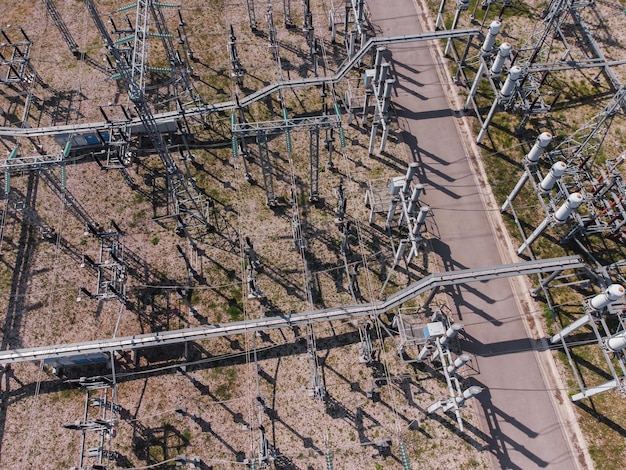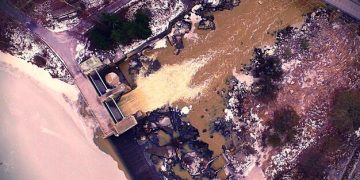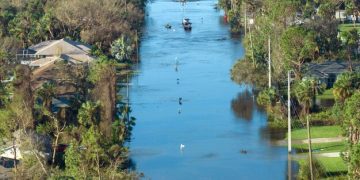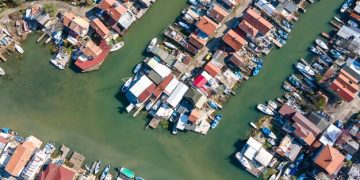US Power Grid: Extreme Heat, AC Demand, and Summer Strain

Extreme heat waves are poised to severely strain the US power grid this summer, as escalating demand for air conditioning, driven by rising temperatures, threatens to overwhelm existing infrastructure, potentially leading to widespread outages and grid instability.
As summer approaches, a critical question looms over the United States: Extreme Heat Waves: How Will Increased Demand for Air Conditioning Strain the US Power Grid This Summer? The mercury is rising, and with it, concerns about the nation’s ability to keep homes and businesses cool without overwhelming its aging energy infrastructure. This summer could indeed present an unprecedented test for power grids across the country.
The Looming Threat of Extreme Summer Heat
The United States is bracing for a summer marked by potentially record-breaking temperatures, a trend exacerbated by the accelerating pace of climate change. This isn’t merely about uncomfortable days; it’s about the systemic pressure these extreme conditions place on vital infrastructure, particularly the nation’s electricity grid.
Scientific projections and historical data indicate an undeniable upward trajectory in global temperatures. Every year seems to bring new records, and the forecast for this summer suggests a continuation of this alarming pattern. Hotter temperatures translate directly into a surge in demand for cooling, primarily through air conditioning units in homes, offices, and commercial establishments.
Historical Heatwave Impact on Grid Stability
Looking back at previous summers, we can observe a clear correlation between prolonged heatwaves and stress on the power grid. For instance, severe heat events in Texas in 2021 and California in 2022 highlighted the grid’s vulnerability when demand peaks unexpectedly. These episodes often led to calls for voluntary conservation or, in more severe cases, rolling blackouts.
- Texas Winter Storm Uri (2021): While a winter event, it exposed grid vulnerabilities to extreme weather, underscoring the need for robust, all-season resilience.
- California Heatwave (2020 & 2022): Consecutive years saw grid operators issue emergency alerts, narrowly avoiding widespread outages due to record-breaking demand.
- Midwest Heatwaves (Recent Years): Several states have experienced localized outages as transformers and distribution lines struggled under sustained, heavy loads.
The challenge isn’t just the sheer volume of electricity consumed, but also the sustained nature of the demand. Unlike brief spikes, prolonged heatwaves mean air conditioning units run for days or even weeks on end, placing continuous strain on generation facilities, transmission lines, and local distribution networks. This relentless demand can push equipment past its operational limits, leading to failures and disruptions across the system.
Recognizing these patterns is crucial for understanding the preventative measures and systemic changes required to bolster grid resilience. The increasing frequency and intensity of extreme heat events make this an urgent priority for energy planners and policymakers across the nation.
America’s Reliance on Air Conditioning: A Double-Edged Sword
Air conditioning, once a luxury, has become a necessity for survival in many parts of the United States, particularly as temperatures soar. This widespread reliance, however, presents a significant challenge to the nation’s energy infrastructure, creating a direct link between rising heat and potential grid instability.
The vast majority of American households and commercial buildings now depend on air conditioning for comfort and safety. This translates into a massive collective demand for electricity, especially during peak heat hours. When sweltering temperatures hit simultaneously across large regions, millions of AC units kick into high gear, drawing immense amounts of power from the grid.
Peak Load Challenges and Infrastructure Limits
The primary concern for grid operators during summer heatwaves is managing “peak load” – the maximum demand for electricity at any given time. This typically occurs in the late afternoon or early evening when people return home from work and simultaneously turn on their AC units, often compounding with commercial cooling needs.
- Generation Capacity: While the US has substantial generating capacity, not all plants are operational 24/7 or can ramp up quickly enough to meet sudden, high demand.
- Transmission Constraints: The network of high-voltage lines that move electricity across states can become bottlenecks, limiting flow to high-demand areas.
- Distribution System Stress: Local transformers and power lines, especially in older neighborhoods, can overheat and fail under sustained heavy loads.
This challenge is further complicated by the aging nature of much of the US electricity infrastructure. Decades of underinvestment in maintenance and modernization mean many components are not designed to withstand the continuous, extreme stress imposed by current and future climate conditions. Transformers can blow, cables can melt, and even power plants can experience forced outages if cooling water becomes too warm or equipment overheats.
The delicate balance between electricity supply and demand is increasingly precarious. Grid operators must perform a continual high-wire act, ensuring that every kilowatt generated is matched by a kilowatt consumed, moment by moment. A sudden surge in AC demand can quickly tip this balance, potentially leading to cascading failures if not managed meticulously and proactively. This reliance on AC, while assuring comfort, is simultaneously exposing fundamental vulnerabilities in how America cools itself.
Aging Infrastructure and Grid Modernization Needs
The backbone of the US power grid, much of it constructed in the mid-20th century, faces significant challenges in meeting 21st-century demands, particularly in the face of escalating climate impacts. An aging infrastructure is a crucial vulnerability, and the imperative for modernization cannot be overstated.
Many of the nation’s power plants, transmission lines, and distribution networks are operating beyond their intended lifespan. Circuit breakers, transformers, and switchgear, essential components for reliable power delivery, are often decades old. This means they are less efficient, more prone to mechanical failure, and less resilient to extreme weather events like prolonged heatwaves.
The Transmission Bottleneck and Distribution Vulnerabilities
A significant portion of the grid’s vulnerability lies in its transmission and distribution segments. The long-distance transmission lines, designed to carry bulk power, can become overloaded during peak demand, especially when power needs to be imported from distant generation sources. These lines also experience “line losses” – electricity dissipated as heat during transmission – which become more pronounced under high loads.
- Interconnections: While North America has three major interconnections (Eastern, Western, and Texas), the ability to seamlessly transfer power between them is often limited by regulatory hurdles and insufficient cross-tie capacities.
- Local Substation Failures: These critical hubs step down high-voltage power for local use. Overheating during extreme heat is a common cause of localized outages, affecting thousands of customers at a time.
- Underground vs. Overhead Lines: While underground lines are less susceptible to wind and ice, they are costlier to install and repair, and can still be affected by ground heat. Overhead lines are exposed to direct sunlight and ambient heat, leading to increased sag and potential contact with vegetation.
Beyond the physical limitations, the grid also lacks the “smart” capabilities that characterize modern infrastructure. Many parts still rely on outdated analog controls and manual intervention, rather than advanced digital systems that can rapidly detect, isolate, and reroute power during disturbances. This lack of real-time visibility and control hinders quick responses to developing issues caused by surging demand.

Modernization efforts are underway, but they face considerable hurdles, including significant capital investment, complex regulatory environments, and public resistance to new infrastructure projects. However, without substantial upgrades, the US power grid will continue to be outmatched by the growing demands placed upon it by climate change.
Renewable Energy and Grid Stability: A Complex Relationship
The increasing integration of renewable energy sources into the US power grid offers both immense potential and significant challenges for stability, particularly in the context of extreme heat waves and soaring air conditioning demand. While renewables are crucial for decarbonization, their intermittent nature complicates grid management.
Solar and wind power are becoming mainstays of electricity generation, providing clean energy and reducing reliance on fossil fuels. During daylight hours, solar farms can contribute significantly to meeting part of the peak demand associated with air conditioning. Wind power also plays a role, though its output is less directly correlated with peak heat periods in all regions.
Intermittency and Storage Solutions
However, the fundamental challenge with these resources is their intermittency. Solar power drops off just as residential AC demand often peaks in the early evening, and wind output can be unpredictable. This creates a “duck curve” phenomenon, where net demand (total load minus renewable generation) rises sharply in the late afternoon, requiring rapid ramping up of traditional power plants or robust energy storage solutions.
- Battery Storage: Large-scale battery storage, particularly lithium-ion, is critical for absorbing excess renewable energy during off-peak hours and discharging it during peak demand, effectively firming up renewable output.
- Hydropower and Pumped Hydro: Existing hydropower facilities offer a flexible source of dispatchable power, and pumped hydro storage can provide large-scale, long-duration energy reserves.
- Demand Response Programs: Incentivizing consumers to reduce electricity use during peak times, often through smart thermostats and grid-connected appliances, can flatten the demand curve.
While the transition to renewables is essential, it necessitates a parallel investment in grid modernization and energy storage technologies. Without adequate storage or flexible backup generation, an over-reliance on intermittent renewables could expose the grid to greater instability during extreme weather events, especially if conventional power plants are retired prematurely without sufficient replacement capacity.
Furthermore, the physical placement of renewable energy projects often requires substantial upgrades to transmission lines to bring power from remote generation sites to demand centers. This highlights that the move to a cleaner energy future is not just about building new power plants, but fundamentally transforming how electricity is generated, stored, and delivered across the nation.
The Economic and Social Consequences of Grid Failure
Beyond the immediate discomfort, a widespread failure of the US power grid during extreme heat waves carries profound economic and social consequences. The ripple effects extend far beyond darkened homes, touching nearly every aspect of modern life and disproportionately affecting vulnerable populations.
Economically, power outages can be devastating. Businesses, from small local shops to large industrial plants, may be forced to shut down, leading to lost productivity and revenue. Supply chains are disrupted, perishable goods are spoiled, and critical infrastructure, like data centers and financial institutions, face immense operational challenges. The cumulative cost of widespread outages over a hot summer could run into billions of dollars, impacting national GDP and individual livelihoods.
Impact on Public Health and Essential Services
From a social perspective, the impact is even more critical and potentially life-threatening. Extreme heat puts immense strain on the human body, especially for the elderly, young children, and individuals with chronic health conditions. Without air conditioning, heatstroke and other heat-related illnesses become a severe public health crisis, leading to increased emergency room visits and even fatalities.
- Healthcare Systems: Hospitals and clinics rely on uninterrupted power for critical medical equipment, refrigerated medications, and patient care. Outages can severely compromise their ability to function.
- Water Supply: Most municipal water systems rely on electric pumps. Power failures can disrupt water purification and delivery, leading to shortages of drinking water and sanitation issues.
- Communication Networks: Cell towers and internet infrastructure require electricity. Prolonged outages can cut off communication, isolating communities and hindering emergency response efforts.
The social fabric can also fray during extended periods without power. Food spoiled, essential medications unrefrigerated, and the inability to communicate with loved ones can create widespread anxiety and distress. Vulnerable communities, often those with limited resources to prepare for or recover from outages, bear the brunt of these impacts, exacerbating existing inequalities.
Moreover, the trust in public services can erode. When basic necessities like power fail, it breeds frustration and a sense of insecurity among the populace. The cumulative effect of these disruptions underscores that grid resilience isn’t just an engineering challenge; it’s a fundamental aspect of public safety, economic stability, and social well-being.
Mitigating the Strain: Strategies for a Resilient Grid
Addressing the escalating strain on the US power grid from extreme heat waves requires a multifaceted and proactive approach. A combination of technological upgrades, policy changes, and behavioral shifts is essential to build a more resilient and sustainable energy future.
At the core of mitigation efforts lies substantial investment in grid modernization. This includes upgrading aging transmission and distribution lines, installing “smart grid” technologies for real-time monitoring and control, and deploying advanced sensors to predict and prevent outages. Such investments enhance efficiency, reduce losses, and enable quicker recovery from disruptions.
Key Strategies for Enhanced Resilience
Diverse strategies are being explored and implemented to bolster the grid’s ability to withstand extreme demand:
- Increased Generation Capacity: Investing in new, flexible power generation facilities that can quickly come online during peak demand, including natural gas peaker plants or advanced nuclear reactors.
- Energy Storage Solutions: Rapid deployment of battery storage systems at utility-scale and distributed levels to capture excess renewable energy and discharge it when needed most.
- Demand-Side Management (DSM): Implementing programs that incentivize consumers to reduce electricity consumption during peak hours, often through smart thermostats, dynamic pricing, and direct load control programs.
- Decentralized Energy Systems: Promoting microgrids and distributed generation (e.g., rooftop solar with battery storage) to allow communities or critical facilities to operate independently when the main grid is down.
- Grid Hardening: Strengthening infrastructure against extreme weather, including burying power lines in vulnerable areas, advanced vegetation management, and using more robust materials for poles and wires.
- Inter-regional Transmission: Improving the capacity to transfer power efficiently between different electricity markets and regions, allowing areas with surplus power to support those experiencing shortages.
Policy reforms are also vital. Streamlining permitting processes for new transmission lines and renewable projects, establishing clear federal mandates for grid resilience investments, and incentivizing the development of innovative energy technologies can accelerate progress. Additionally, public education campaigns can empower consumers to make energy-saving choices, particularly during heat advisories.
Ultimately, a resilient grid is one that can adapt to changing climate conditions, integrate diverse energy sources, and respond flexibly to demand fluctuations. It’s a continuous process of investment, innovation, and strategic planning, essential for ensuring that air conditioning remains a source of comfort, not anxiety, during the increasingly hot American summers.
| Key Point | Brief Description |
|---|---|
| 🌡️ Extreme Heat Threat | Rising temperatures increase AC demand, straining an already vulnerable US power grid. |
| ⚡ AC Demand & Peak Load | Widespread air conditioning use creates massive peak electricity demand, challenging grid capacity. |
| 👴 Aging Infrastructure | Much of the grid is outdated, leading to inefficiency and higher risk of failure during stress. |
| Futuristic Grid Solutions | Modernization, renewable energy integration with storage, and demand-side management are crucial for resilience. |
Frequently Asked Questions
▼
Extreme heat waves drive a massive surge in demand for air conditioning, leading to peak electricity loads that can overwhelm the grid’s generation and transmission capabilities. This increased and sustained demand puts immense stress on aging infrastructure, risking outages and instability across the system.
▼
Transmission lines can bottleneck power flow, and local distribution components like transformers become prone to overheating and failure during prolonged high demand. Older substations and their equipment may not be designed to handle current and projected loads, leading to localized or widespread service interruptions during heat events.
▼
While clean, renewables like solar and wind are intermittent. Solar output drops as evening AC demand peaks, creating a challenge. Without sufficient battery storage or flexible backup, their variability can complicate grid management, especially when traditional power plants struggle to ramp up quickly to meet sudden demand surges.
▼
A widespread grid failure during a heat wave can have severe economic and social consequences. Businesses shut down, supply chains are disrupted, and there’s a significant risk to public health, especially for vulnerable populations without access to cooling. Essential services like water supply and communication can also be severely impacted.
▼
Efforts to strengthen the grid include significant investment in modernization, deploying smart grid technologies, expanding energy storage, and implementing demand-side management programs. Additionally, enhancing inter-regional transmission capacity and hardening infrastructure against extreme weather events are crucial steps towards building a more resilient system for future summers.
Conclusion
The convergence of extreme heat waves and escalating air conditioning demand presents a formidable challenge to the US power grid. This summer stands as a critical test for an infrastructure largely built for a different climate and a different era of energy consumption. While the complexities of grid modernization, renewable energy integration, and infrastructure hardening are immense, the imperative is clear: investing in a resilient, future-ready grid is not merely an economic consideration, but a fundamental matter of public safety and national security. The collective effort across government, industry, and individual consumers will determine how well the nation withstands the heat, ensuring that essential cooling remains accessible as temperatures continue to rise.





